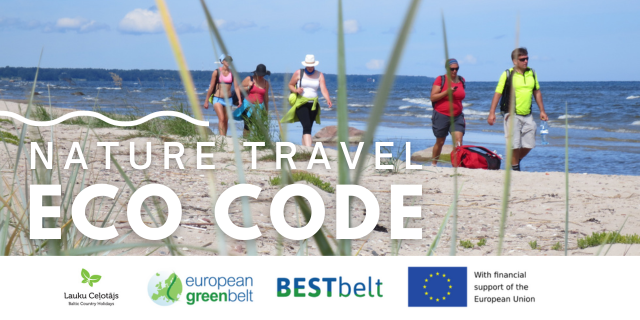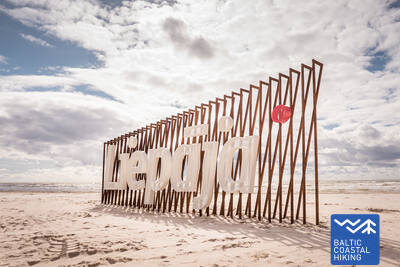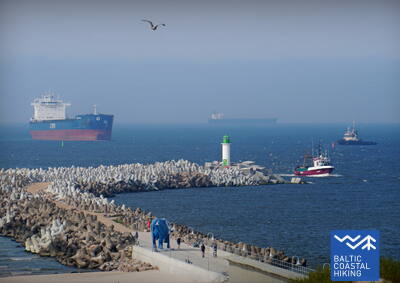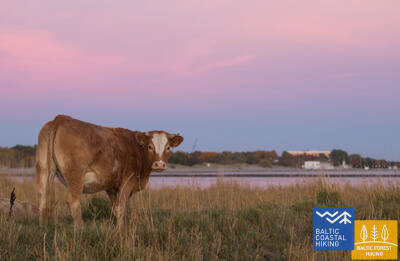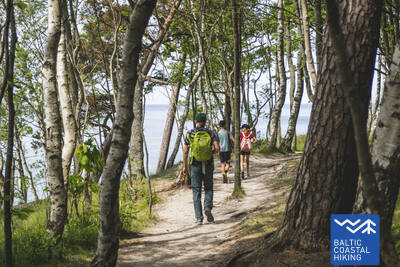Baltic Coastal Hiking trail - Family pleasure
 Section 3. Bernāti - Liepāja - Karosta (The War Port).
Section 3. Bernāti - Liepāja - Karosta (The War Port).
The City Where The Wind Is Born
From Bernāti to Liepāja, the Baltic Coastal Hiking Route leads through a wide beach where initially the coast is formed by washed away shores, but as you approach Liepāja high foredunes covered in sand ryegrass and marram grass appear in sight. Later the trail winds through the old town of Liepāja and “New Liepāja”, crossing the Naval Port Canal to reach the Naval Port: a complex of military and fortification buildings the visitation of which is likely to take a half day. You should certainly try the special dish of Liepāja called Liepājas menciņi made of smoked cod according to an ancient recipe from Southern Kurzeme.
 Section 10. Ventspils - Staldzene.
Section 10. Ventspils - Staldzene.
Through Ventspils
The itinerary goes through Ventspils and its surrounding forests. The Baltic Coastal Hiking Route winds from the South Pier through the historic Ostgals and the Old Town, crosses the Venta River and continues through the Pārventa District via a pedestrian and cyclist path in the direction of Staldzene where it circles the Ventspils Port and then returns to the seacoast. It is worth taking one “day off” and get to know the most interesting places in the city, as well as visit the Seaside Open-Air Museum.
 Section 15. Saunags village – Kolka.
Section 15. Saunags village – Kolka.
The Heart Of Europe: Cape Kolka
The Baltic Coastal Hiking Route winds through small country and forest roads from Saunags village to Vaide village where it returns to the seacoast again. Wide sandy beaches stretch up to Cape Kolka turning into low sparse foredunes; wooded seaside dunes continue behind them. For around 2 km, there are washed away dunes followed by the Dumbrkalni Hills. Cape Kolka, the point where the Great Sea meets the Little Sea, is one of the most popular bird-watching sites on the Baltic seacoast.
 Section 34. Uulu - Pärnu.
Section 34. Uulu - Pärnu.
Along the Wetlands to Pärnu
First, the Baltic Coastal Hiking Route takes the old coastal roads surrounded by pine forests, but after passing Lottemaa Park it turns towards the sea and comes out at Reiu beach. Next, the hike continues across an overgrown beach (wide shoals when the winds create an outflow of water) and after a little less than 4 km you have to turn inland, cross a golf course and turn in the direction of Pärnu. Near the Raeküla district, it snakes along a small trail forming the border between the large coastal wetland and the forest. Having looped around the wetland for ~ 6 km, the Baltic Coastal Hiking Route emerges at Pärnu beach. Further on, the road goes through the western part of Pärnu Old Town, crosses the Pärnu River and the Sauga River and ends in the Vana-Pärnu district.
The parks and coastal promenades and pedestrian paths in Pärnu are suitable for people with strollers. The amusement park Lottemaa is located in Reiu village, between Uulu and Pärnu. It is suitable for families and small children, with activities available in various languages (EST, LAT, FIN, LAT, RU).
 Section 35. Pärnu - Liu.
Section 35. Pärnu - Liu.
The Most Beautiful Views of Pärnu Bay and Smoked Fish
The Baltic Coastal Hiking Route meanders on the outskirts of the west of Pärnu, crosses the Audru River and turns towards Valgeranna, the southern side of which is surrounded by a thick forest and a white sandy beach, while to the north you will find a golf course. After passing Valgeranna, the Baltic Coastal Hiking Route advances between the polders across the northern part of Pärnu Bay. From the Audru polders you will see the most spectacular views of Pärnu Bay. After Audru reeds, the Baltic Coastal Hiking Route turns south and leads through coastal fishing villages with small ports and berths. Here you can see the daily life of fishermen and if you are lucky, then also taste smoked fish.
 Section 48. Rohuküla - Haapsalu - Uuemõisa.
Section 48. Rohuküla - Haapsalu - Uuemõisa.
The Most Popular Resort in Estonia - Haapsalu
A multifarious section of the Baltic Coastal Hiking Route. The first three kilometres of the itinerary go along the former Haapsalu – Rohuküla broad-gauge railway line, takes you on a stroll along Haapsalu Bay through Pullapää cape, crosses coastal forests, which contain health trails, and continues via coastal promenades and small streets around Haapsalu Town. After crossing a small wetland beyond the town, this section of the trail ends in the beautiful Uuemõisa Park.
The childhood of Ilon Wikland, the illustrator of the world-famous children's author Astrid Lindgren's books, was spent in Haapsalu, where in the 1930s she lived with her parents in a yellow house at the corner of Linda and Rüütli streets. Ilon Wikland has donated 800 of her drawings to the city of Haapsalu, which can be seen at the gallery on Kooli Street, where the children's theme park Ilon's Wonderland is also located. Ilon Wikland's childhood home can only be viewed from the outside. Many places in Haapsalu are adapted for parents with strollers - Väike viik lake shore, Haapsalu promenade, Üümeisa park, and more.
 Section 57. Kersalu - Laulasmaa.
Section 57. Kersalu - Laulasmaa.
Beaches, Swimming Areas and a Resort
The itinerary leads along the seashore and small coastal villages. Near Kersalu, the Baltic Coastal Hiking Route approaches a rocky shore, where among the trees you will see cliffs rising several meters. When approaching Kloogaranna, wide sandy beaches and dunes appear. Near Kloogaranna beach, the Baltic Coastal Hiking Route turns towards a village, takes you on a stroll of ~ 3 km through the inland and then returns to the seashore.
 Section 60. Tabasalu - Tallinna sadam.
Section 60. Tabasalu - Tallinna sadam.
Tallinn – A UNESCO World Heritage Site
Near Tabasalu, the Baltic Coastal Hiking Route crosses the boundary of Tallinn and goes through the Tiskre and Vismeistri districts to reach Kakumäe beach, where it takes you on a stroll around the wooded upper part of the Kakumäe Peninsula surrounded by cliffs. Here, you will have a vista of the Port of Tallinn across Kopli Bay. Opposite the Õismäe district, an excellent promenade goes along the seashore. After bypassing the Estonian Open-Air Museum, the Baltic Coastal Hiking Route winds along the coastal promenade up to Stroomi beach and after passing the Pelguranna district it takes pedestrian sidewalks to the Estonian Maritime Museum, where it leads you, via the coastal promenade, to the Port of Tallinn, marking the end of the Baltic Coastal Hiking Route. You have covered ~ 620 km in Estonia.
 Section 67. Klaipėda – Palanga.
Section 67. Klaipėda – Palanga.
Through the Seaside Regional Park
Following H. Manto Street, the Baltic Coastal Hiking Route leads out of the center of Klaipėda, traverses the Klaipėda Recreation Park, crosses a railway line by bridge and comes out onto the coast of the Baltic Sea in the southern part of Melnragė. The trail then winds through the dunes, for the protection of which wooden walkways have been installed, and continues on along a beautiful path through the coastal forest, following at a distance of about 10–20 m the pedestrian/cyclist lane through Antroji Melnragė to Giruliai. At Giruliai, it briefly comes out onto the beach, but from Kukuliškiai to the southern part of Karklė Village, the Baltic Coastal Hiking Route first passes along the incredibly beautiful coastline of the former Littorina Sea covered in primeval forest, and later, along a scenic bluff, created by the washing of waves; there are several viewing points along the way (including the Dutchman's Cap). From the Village of Karklė for the next 11 km to the Palanga Botanical Park, the Baltic Coastal Hiking Route leads across sandy and pebbly, occasionally rocky beaches. Through the coastal pathways in the western part of the Palanga Botanical Park, the trail leads over to Meilės avenue and then to the Palanga pedestrian bridge. Most of this section of the trail leads through the Seaside Regional Park.










